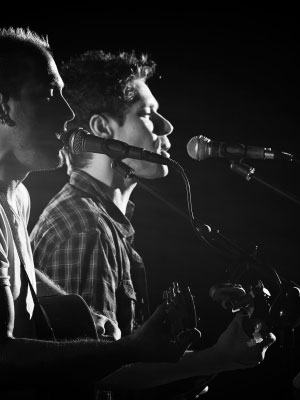 One of the main reasons I got into recording audio was frustration that none of my friends seemed to know what harmonies were – even if they could sing quite well. So I decided the only way to sing cool harmonies was to do it with myself. I had an old cassette tape recorder with a tiny crappy mic on it. And my brother had a boom-box that could play cassette tapes. This was long before the days of portable CD players, and certainly long, LONG before the advent of mp3 players.
One of the main reasons I got into recording audio was frustration that none of my friends seemed to know what harmonies were – even if they could sing quite well. So I decided the only way to sing cool harmonies was to do it with myself. I had an old cassette tape recorder with a tiny crappy mic on it. And my brother had a boom-box that could play cassette tapes. This was long before the days of portable CD players, and certainly long, LONG before the advent of mp3 players.
So I sand the melody of This Boy, by the Beatles, onto my tape recorder. Then I ejected the tape and put it into my brother’s boom box, placing a new cassette tape into my tape recorder. Then I played back the part I just sang from the boom box, recording it onto my recorder while singing George’s harmony. Then I took THAT tape out of my recorder, stuck it into the boom box, and put the other tape back into the recorder and pressed “play” on the boom box while recording it onto my recorder and singing Paul’s part. Voila! 3-part harmony with myself. It was like magic – pure, hissy (boy was there a lot of tape hiss noise!) vocal harmony magic.
Well, I messed with all the technology through the years and in 2013, we have wonderfully quiet, high-quality recording tech at our fingertips for just a few bucks. I’ve been doing harmony with that tech on this site. Below are some of the examples of what you can do now.
Our courses – The Newbies Guide To Audio Recording Awesomeness 1: The Basics With Audacity, and The Newbies Guide To Audio Recording Awesomeness 2: Pro Recording With Reaper, both show you step-by-step how to sing harmony with yourself. Also, see the article whose link is at the bottom of the page with one of the first articles we ever published – Sing Harmony With Yourself – Learn How to Record Your Voice on Your PC and Sing Along With It!
Music Recording
What Is A Decibel In Audio Recording?
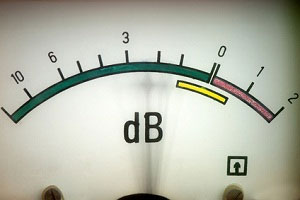 The term “decibel” is used a LOT in audio recording and live sound. You usually see it written as “dB,” and talked about primarily when discussing frequency stuff, especially in the topics of EQ and compression. Besides sounding vaguely like something to do with the decimal system, what does it mean?
The term “decibel” is used a LOT in audio recording and live sound. You usually see it written as “dB,” and talked about primarily when discussing frequency stuff, especially in the topics of EQ and compression. Besides sounding vaguely like something to do with the decimal system, what does it mean?
Well, the short answer – and the one that will be most useful to you without having to know the gory technical details – is that it is a unit of measure for how loud audio is. For example, when you want to know how long something is, you measure in units of inches, feet, yards, etc. Or if you use the decimal system, centimeters, meters, etc. The decibel is something like that, only for loudness of audio, and it uses the decimal system like a lot of things in audio.
But there are some funky things about the decibel. For one thing, it is almost always referred to as a negative number in digital audio, where zero is the top of the scale. What? Yup. It’s like going through the looking glass and doing everything backwards. If you want to make -20 dB audio louder, you turn it up until it gets to -15 dB, or more. See? Funky!
In fact it’s so funky that there is a move afoot (or should that be “adecimeter”? – ha! Sorry:)) to do away with it altogether in the audio recording world! And in a world where obtuse and often needlessly complicated terms are commonplace, that is saying something.
Here is a terrific article from Recording Magazine by Alex Case about the decibel, which is written in a pretty easy-to-understand way. Still, the term “logarithm” does appear. So be prepared to put on your math trousers.
The article is here: http://www.recordingmag.com/resources/resourceDetail/265.html
Mixing Contest by PureMix
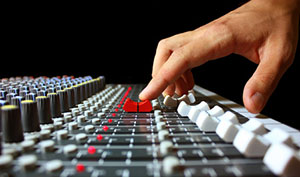 Mixing contest alert! PureMix is a site with audio recording, mixing and processing tutorial videos that make it sort of feel like you are working as a learning assistant to a professional studio engineer. Pretty cool stuff. You can check them out here: http://www.puremix.net/about-us.html.
Mixing contest alert! PureMix is a site with audio recording, mixing and processing tutorial videos that make it sort of feel like you are working as a learning assistant to a professional studio engineer. Pretty cool stuff. You can check them out here: http://www.puremix.net/about-us.html.
This month and next (April and May 2013), in association with Sweetwater Pro Audio and Dangerous Music (makers of high-end audio gear), are doing something very cool and fun. They are holding a massive mixing contest! How would something like that work? Well, they provide some audio files and you mix them together and render your version. In this case, they are providing tracks from singer, Liza Colby Sound’s song “Oh Baby.” Then you have until June 1st to create your own mix of the song using the files you downloaded. Sounds like a blast!
The rule is that you cannot change the arrangement. In other words, you cannot add other instruments or sounds. Your job will be to put use just panning, volume and effects to blend/mix everything together, then mix it down (see our article What Does It Mean to Mix Down Audio?) to one audio file and upload it to your SoundCloud account (it’s free) and then submit your masterpiece by June 1st, 2013.
Sweetwater, online retailers of recording and musical gear and one of the sponsors of this contest, will be announcing the winners of the contest during their annual GearFest event on June 21st and 22nd.
There will be 16 top candidates announced on June 21st, who will all be awarded prizes ranging from $3,990 (pair of Focal Twin6 Be speakers) for first prize, all the way down to a $269 value for a one-year subscription to PureMix. In between are various microphones and other audio goodness. You’ll get a list as soon as you sign up.
I already entered, downloaded my files and loaded them up in my DAW (“digital audio workstation” – another way of saying “multi-track recording software”) of choice – Reaper. Of course you can use whatever DAW you wish, or you could do it the old fashioned way and use analog tape if you have the gear for it.
What are you waiting for? Go sign up here: http://www.puremix.net/gearfestmixingcontest
New Virtual Synthesizer From Sample Logic – Cyclone
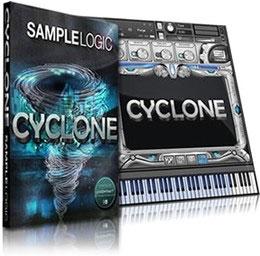 Sample Logic, makers of excellent virtual instruments and synthesizers such as The Elements Exp Virtual Instrument Library Software
Sample Logic, makers of excellent virtual instruments and synthesizers such as The Elements Exp Virtual Instrument Library Software and a lot more besides, has announced the release of their latest synth called Cyclone.
From the description on their website, it will use Native Instruments Kontakt (Cyclone will come with Kontakt player with 64-bit support) and be a combo instrument in that it plays sampled instruments (325 different types) as well as having the capability to act as a synthesizer, meaning you can alter the sounds with Sample Logic’s sequencer, arpeggiator and LFO (low-frequency oscillator), as well as the new Kontakt additive synthesis engine called “Wave.”
The kinds of instruments and sounds described, namely single instruments and multis giving you motion pads, cinematic instruments, dub-step type basses, electronic leads and much more. It sounded a lot to me like Omnisphere, by Spectrasonics. But Cyclone will be a bit a bit less expensive than Omnisphere’s $479, coming in at just under $300.
It’s scheduled to be released on April 22nd, 2013. So be ready if you’ve been looking for a great all-around virtual synth.
Obsessive In The Mixing Stage Of Recording
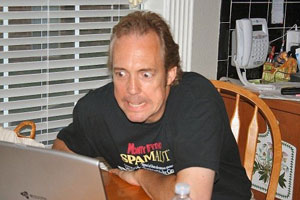 There has been a lot of attention in the online audio recording space about mixing lately. It’s as if two things pervade the rest of the folks teaching and talking about home recording: the idea that music is the only thing people are doing (voice-over recording rarely involves much in the way of mixing – maybe background music and that’s usually it), and that if you are recording music, mixing is the most important part of doing it.
There has been a lot of attention in the online audio recording space about mixing lately. It’s as if two things pervade the rest of the folks teaching and talking about home recording: the idea that music is the only thing people are doing (voice-over recording rarely involves much in the way of mixing – maybe background music and that’s usually it), and that if you are recording music, mixing is the most important part of doing it.
Here are Home Brew Audio, we talk about both music AND voice-over recording. I know there is a very large proportion of the home recording space devoted to voice-over recording. Plus I am a voice-over actor. So we devote a significant percentage of our content to VO stuff.
The second seemingly pervasive presupposition is that between the mixing and record phases of a music recording project, it’s the mixing that is the most important. It follows, then, that a majority of producing time, assuming you do all your own recording (tracking), mixing and mastering (see our article on these three phases of a recording project – Recording Engineer, Mix Engineer and Mastering Engineer – Oh My), a majority of the time spent on the project should be mixing, as opposed to recording/tracking. I actually agree with that. It’s certainly true for me anyway.
My music niche – the renaissance re-enactors and medieval re-creation folks (mainly SCA) – has a LOT of musicians writing and recording songs. Most of them have the same basic equipment – a decent computer audio interface and a few decent mics along with some recording software. But (and this is going to sound a bit like boasting, but its true) so many people ask me what my secret is to getting such a professional sound compared to a majority of the other recordings out there in my niche. And you know what the answer is? OCD! OK, well that may be over-stating things a bit (no it isn’t!), but I spend a LOT more time mixing than recording. My recording to mix ratio is like 1:10.
I truly believe this is where the difference is made. Since I mix in a converted bedroom like most home recordists, I don’t have an ideal mixing space. So to get a good portable mix (one that will sound just as good in the car, on an iPod or on a large entertainment system), I have to literally mix for each of those playback systems. I start out with a draft mix, then take it with me in the car. It will have several balance problems – bass to loud or not loud enough, lead vocal uneven, can’t hear the drum, etc. So I take copious notes and go back to the computer and make adjustments. Then I take it with me in the car again. This repeats at least 3 or 4 times.
Then I will listen in headphones on an iPod. I’ll notice some problems that didn’t come across in the car, usually excess sibilance (SSS sounds) and maybe some more vocal mix issues. So I repeat the process until it now sounds good on both a car stereo and in the headphones with an iPod.
Finally, I’ll listen on the big stereo in the living room (CD player). I’ll notice some more problems there – typically to do with the way the lead vocal sits in the mix, but also problems in the high frequencies are usually revealed here, along with issues with reverb. So I go back and remix and repeat the same way as earlier until it sounds great on the big speakers. Then I listen to THAT mix in the car and on the iPod until it sounds great in all three places.
If I were wealthy and could afford to build an awesome acoustically ideal mixing/mastering listening space, along with a pair of high-end mixing loudspeakers (actually two or three different pair of monitors), I could save a lot of time in the mixing stage. But I can’t afford that yet. And until I do, I am going to get comfortable with my OCD in the mixing stage.